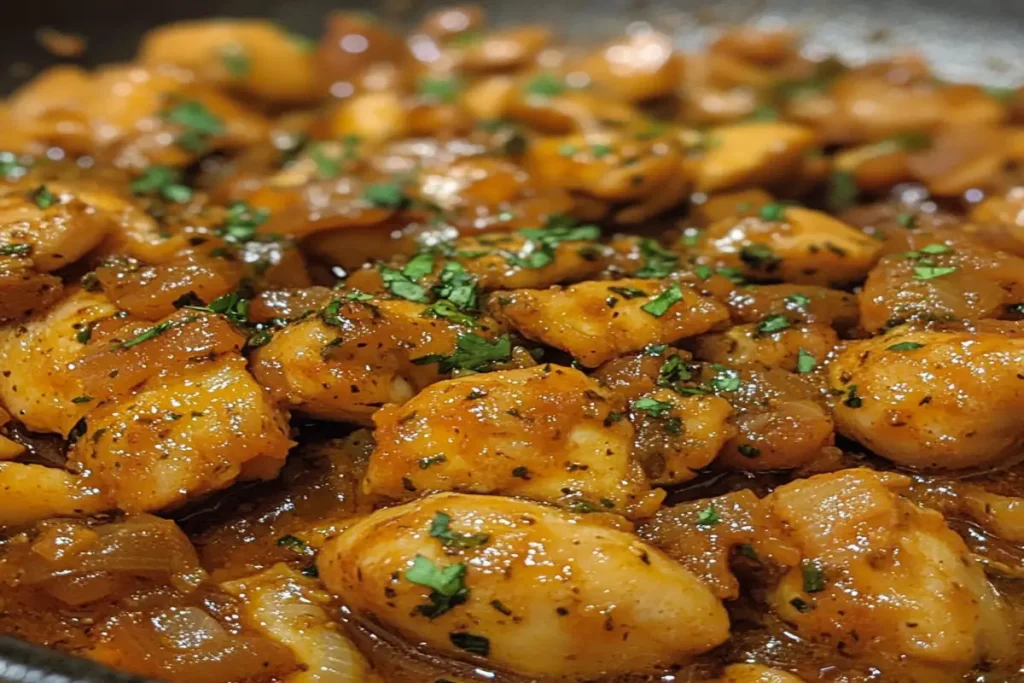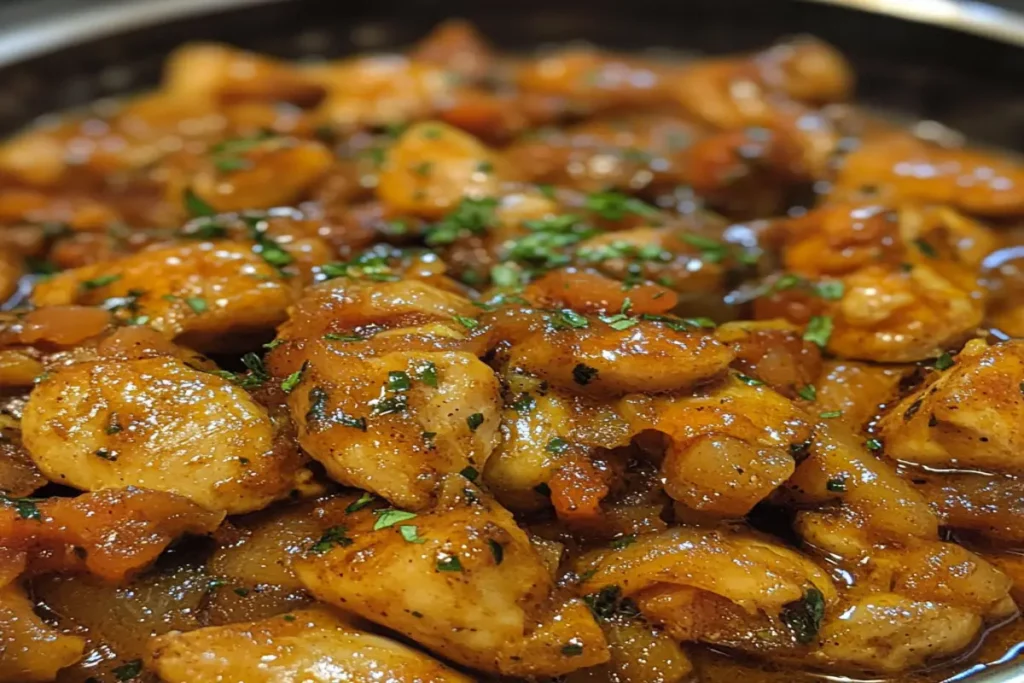Introduction: Why Keeping Chicken Moist Matters
Cooking chicken perfectly can be challenging, especially when it comes to retaining moisture. What cooking method keeps chicken moist is a question many home cooks and professionals alike often ask. Moist chicken not only enhances the overall taste but also ensures a better texture and nutritional value. Dry or overcooked chicken can ruin a dish and deter even the most loyal food enthusiasts.
Achieving juiciness in chicken requires attention to cooking techniques, preparation, and ingredients. By understanding the nuances of moisture retention, you can elevate simple chicken recipes into delightful meals. In this article, we will explore the essential methods, tools, and tips for consistently achieving moist and juicy chicken. Whether you prefer roasting, grilling, or slow cooking, there are steps you can take to ensure your chicken is flavorful and tender every time.
Key Ingredients for Moist and Juicy Chicken
The secret to moist chicken often starts with selecting the right ingredients. When considering what cooking method keeps chicken moist, the preparation phase plays a critical role.
- Fresh Chicken: Using fresh chicken with no signs of freezer burn ensures better moisture retention.
- Fat Sources: Oils, butter, or natural fats like chicken skin contribute to juicy results.
- Acids: Ingredients such as lemon juice, vinegar, or yogurt tenderize the meat and lock in moisture.
- Salt: Essential for brining, salt enhances both flavor and moisture.
Adding complementary ingredients like herbs, garlic, or spices can also enrich flavor profiles while ensuring the chicken doesn’t dry out during cooking. Balancing these elements is the first step to achieving that perfectly moist bite every time.
Understanding the Science Behind Moist Chicken

To understand what cooking method keeps chicken moist, it’s essential to grasp the science behind meat and moisture. Chicken consists of protein fibers that contract when exposed to heat. If cooked improperly, these fibers squeeze out water, leaving the meat dry and tough.
Moisture retention depends on controlling two factors:
- Temperature: Cooking chicken at moderate temperatures prevents rapid water loss.
- Time: Overcooking, even at the right temperature, can result in dryness.
Using thermometers to monitor the internal temperature ensures that chicken stays within the ideal range of 160°F to 165°F. Additionally, resting the chicken post-cooking allows juices to redistribute throughout the meat, preventing it from becoming dry upon cutting.
Step-by-Step Guide to Retaining Chicken’s Juiciness
Achieving moist chicken involves careful steps from start to finish. Here’s a guide to ensuring success:
- Prepare the Chicken: Remove excess moisture using a paper towel for even seasoning.
- Season Generously: Use salt and seasonings liberally to enhance flavor and aid moisture retention.
- Preheat Equipment: Ensure pans or ovens are preheated to promote even cooking.
- Monitor Cooking: Use a meat thermometer to avoid overcooking.
- Rest the Chicken: After cooking, allow the chicken to sit for at least 5 minutes before slicing.
These steps are adaptable to any cooking technique and emphasize the importance of preparation and precision when figuring out what cooking method keeps chicken moist.
The Best Cooking Methods for Moist Chicken
Several methods answer the question of what cooking method keeps chicken moist. Here are some of the most effective:
- Roasting: Cooking chicken in the oven with the skin on helps retain natural juices.
- Grilling: Grilling over indirect heat ensures a charred exterior while keeping the inside moist.
- Sous Vide: This precise method cooks chicken at a consistent temperature, locking in moisture.
- Pan-Seared: Cooking in a skillet with butter or oil creates a moist and flavorful crust.
Each method has unique benefits, but all rely on maintaining the correct temperature and not overcooking. By experimenting with these techniques, you’ll master the art of moist chicken.
How to Brine Chicken for Extra Moisture
Brining is a simple yet highly effective technique for ensuring juicy chicken. When exploring what cooking method keeps chicken moist, brining consistently ranks as a top choice.
Brine Recipe:
- Water: Acts as the base to dissolve the salt.
- Salt: Creates a solution that tenderizes the meat.
- Optional Add-ins: Sugar, herbs, or garlic for added flavor.
Steps to Brine:
- Combine water and salt in a large bowl.
- Submerge the chicken and refrigerate for 4-24 hours.
- Rinse and pat dry before cooking.
This method ensures the meat absorbs extra moisture, making it resistant to drying out during cooking.
Slow Cooking: A Foolproof Way to Keep Chicken Tender
When asking what cooking method keeps chicken moist, slow cooking often emerges as a foolproof solution. This method uses low, consistent heat to break down proteins without losing moisture.
Why Slow Cooking Works:
- Low Temperature: Prevents water loss by gently cooking the meat.
- Enclosed Environment: Traps steam, keeping the chicken surrounded by moisture.
- Time Efficiency: Allows for gradual flavor development.
Using a slow cooker, you can prepare dishes like shredded chicken or creamy chicken casseroles, ensuring the meat remains juicy and tender every time.
The Role of Marinades in Moistening Chicken
Marinades not only enhance flavor but also play a vital role in keeping chicken moist. When considering what cooking method keeps chicken moist, using a marinade adds an additional layer of protection.
Key Components of Marinades:
- Acid: Lemon juice, vinegar, or buttermilk for tenderizing.
- Oil: Prevents drying and helps the chicken absorb flavors.
- Spices and Herbs: Create depth and complexity.
Tips for Marinating:
- Use a resealable bag for even coating.
- Refrigerate for at least 30 minutes but no longer than 24 hours.
- Remove excess marinade before cooking to prevent burning.
By mastering marinades, you can transform simple chicken into a moist and flavorful centerpiece for any meal.
Baking vs. Grilling: Which Keeps Chicken More Juicy?

When deciding what cooking method keeps chicken moist, baking and grilling often come to mind as popular choices. Both methods have their merits, but the best choice depends on your goals.
Baking:
- Even heat distribution ensures consistent cooking.
- Retains moisture by enclosing the chicken in foil or a covered dish.
- Suitable for marinated or breaded chicken to prevent drying out.
Grilling:
- Adds smoky, charred flavors to the chicken.
- Requires attention to avoid overcooking, especially over direct heat.
- Best for cuts like thighs or drumsticks, which retain moisture better.
Choosing between these methods depends on the dish and desired flavor profile, but either can yield moist chicken when done correctly.
Sous Vide: The Secret to Perfectly Moist Chicken
Sous vide has revolutionized the way people cook chicken. This method, often mentioned when asking what cooking method keeps chicken moist, involves vacuum-sealing the chicken and cooking it in a water bath at a precise temperature.
Benefits of Sous Vide:
- Guarantees even cooking throughout the meat.
- Locks in natural juices and flavors.
- Virtually eliminates the risk of overcooking.
Steps for Sous Vide Chicken:
- Season and vacuum-seal the chicken.
- Set the water bath to the desired temperature (e.g., 165°F for fully cooked chicken).
- Cook for 1-2 hours, depending on the thickness.
- Sear briefly in a hot pan for a crispy exterior.
This technique ensures that every bite is tender, juicy, and full of flavor.
Common Mistakes That Lead to Dry Chicken
Avoiding common mistakes is key to mastering what cooking method keeps chicken moist. Here are some pitfalls to watch for:
- Overcooking: The most frequent cause of dryness. Use a thermometer to avoid this.
- Skipping Brining or Marinating: Foregoing these steps can result in bland and dry chicken.
- High Heat for Too Long: Rapid cooking over high heat forces moisture out.
- Slicing Immediately: Cutting chicken without resting it allows juices to escape.
By recognizing and correcting these mistakes, you’ll significantly improve your chicken-cooking results.
Decorating and Serving Moist Chicken for Any Meal
Presentation plays a vital role in enjoying a meal, especially when serving moist chicken. After identifying what cooking method keeps chicken moist, focus on plating and garnishing.
Tips for Decorating:
- Use fresh herbs like parsley or cilantro for a vibrant touch.
- Arrange chicken slices neatly for an elegant look.
- Pair with colorful sides such as roasted vegetables or a fresh salad.
Serving Suggestions:
- Drizzle pan juices or a light sauce over the chicken.
- Serve on decorative platters for a polished appearance.
These steps ensure your chicken not only tastes moist but also looks visually appealing.
Frequently Asked Questions About Moist Chicken Recipes
1. What cooking method keeps chicken moist for meal prep?
Slow cooking or sous vide are ideal for retaining moisture in meal-prepped chicken.
2. Can I freeze cooked chicken without losing moisture?
Yes, if you wrap it tightly in foil or vacuum-seal it before freezing.
3. How can I reheat chicken while keeping it moist?
Use a microwave-safe dish with a damp paper towel or reheat in a covered pan with a splash of broth.
Addressing these FAQs ensures you can maintain moist chicken at every stage of cooking and storage.
Pro Tips for Moist Chicken Every Time
To ensure consistently moist chicken, precision and preparation are key. Always use a meat thermometer to prevent overcooking; chicken should reach an internal temperature of 165°F. Choosing bone-in or skin-on cuts naturally helps lock in moisture during cooking. Another effective tip is to cook chicken in broth or stock for added juiciness and flavor.
Additionally, avoid overcrowding your pan or oven tray, as this can create steam, leading to uneven cooking. Resting chicken for 5-10 minutes after cooking allows the juices to redistribute, ensuring every bite is succulent. Incorporating fats like butter or olive oil while cooking adds flavor and prevents drying. Finally, maintain moderate heat to prevent water loss—high temperatures can dry out chicken quickly. By applying these methods, you’ll master the art of moist chicken and elevate your cooking skills.
Conclusion: Perfecting Your Chicken Cooking Technique
Mastering what cooking method keeps chicken moist requires understanding techniques, preparation, and careful monitoring. Whether you’re baking, grilling, or exploring sous vide, focus on balancing temperature, time, and preparation methods. By applying the tips shared in this article, you can transform ordinary chicken into a succulent and flavorful dish every time. Moist chicken isn’t just a possibility—it’s an achievable goal for every home cook.
Cooking chicken to perfection requires a blend of thoughtful preparation and skillful execution. From selecting the right ingredients to choosing the best cooking methods, every detail matters. By embracing techniques like brining, sous vide, and proper seasoning, you ensure consistently juicy results. Remember, using tools like a meat thermometer and allowing the chicken to rest after cooking are small steps with significant impact. Moist chicken enhances the dining experience and elevates even the simplest recipes. With practice and attention to detail, you can make every chicken dish a masterpiece that’s both delicious and satisfying.

